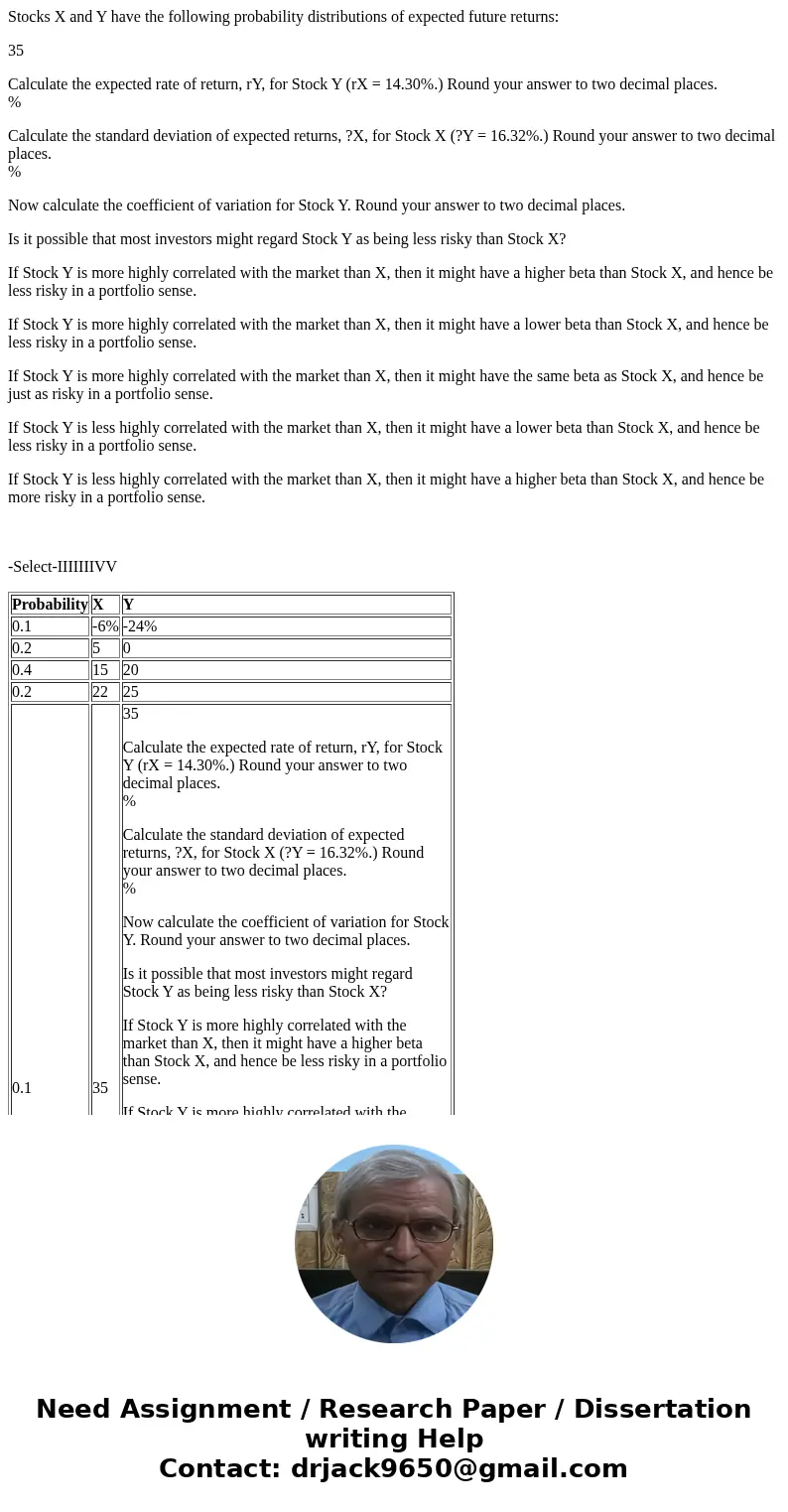Stocks X and Y have the following probability distributions
Stocks X and Y have the following probability distributions of expected future returns:
35
Calculate the expected rate of return, rY, for Stock Y (rX = 14.30%.) Round your answer to two decimal places.
%
Calculate the standard deviation of expected returns, ?X, for Stock X (?Y = 16.32%.) Round your answer to two decimal places.
%
Now calculate the coefficient of variation for Stock Y. Round your answer to two decimal places.
Is it possible that most investors might regard Stock Y as being less risky than Stock X?
If Stock Y is more highly correlated with the market than X, then it might have a higher beta than Stock X, and hence be less risky in a portfolio sense.
If Stock Y is more highly correlated with the market than X, then it might have a lower beta than Stock X, and hence be less risky in a portfolio sense.
If Stock Y is more highly correlated with the market than X, then it might have the same beta as Stock X, and hence be just as risky in a portfolio sense.
If Stock Y is less highly correlated with the market than X, then it might have a lower beta than Stock X, and hence be less risky in a portfolio sense.
If Stock Y is less highly correlated with the market than X, then it might have a higher beta than Stock X, and hence be more risky in a portfolio sense.
-Select-IIIIIIIVV
| Probability | X | Y |
| 0.1 | -6% | -24% |
| 0.2 | 5 | 0 |
| 0.4 | 15 | 20 |
| 0.2 | 22 | 25 |
| 0.1 | 35 | 35 Calculate the expected rate of return, rY, for Stock Y (rX = 14.30%.) Round your answer to two decimal places. Calculate the standard deviation of expected returns, ?X, for Stock X (?Y = 16.32%.) Round your answer to two decimal places. Now calculate the coefficient of variation for Stock Y. Round your answer to two decimal places. Is it possible that most investors might regard Stock Y as being less risky than Stock X? If Stock Y is more highly correlated with the market than X, then it might have a higher beta than Stock X, and hence be less risky in a portfolio sense. If Stock Y is more highly correlated with the market than X, then it might have a lower beta than Stock X, and hence be less risky in a portfolio sense. If Stock Y is more highly correlated with the market than X, then it might have the same beta as Stock X, and hence be just as risky in a portfolio sense. If Stock Y is less highly correlated with the market than X, then it might have a lower beta than Stock X, and hence be less risky in a portfolio sense. If Stock Y is less highly correlated with the market than X, then it might have a higher beta than Stock X, and hence be more risky in a portfolio sense.
|
Solution
Expected rate of return for Stock Y=(0.1*(-24%)+0.2*0%+0.4*20%+0.2*25%+0.1*35%)=14.1%
Standard Deviation of Stock X=sqrt(0.1*(-6%-14.3%)^2+0.2*(5%-14.3%)^2+0.4*(15%-14.3%)^2+0.2*(22%-14.3%)^2+0.1*(35%-14.3%)^2)=10.65%
COefficient of Variation for Stock Y=Standard Deviation for Y/Expected returns for Y=16.32%/14.1%=1.157
If Stock Y is less highly correlated with the market than X, then it might have a lower beta than Stock X, and hence be less risky in a portfolio sense.


 Homework Sourse
Homework Sourse